Mecklenburg-Vorpommern
![]()
This article describes the German state. For other meanings, see Mecklenburg-Vorpommern (disambiguation).
Mecklenburg-Vorpommern [ˈmeːklənbʊʁk ˈfoːɐ̯pʰɔmɐn] (Low German Mäkelborg-Vörpommern ['mɛːkl̩bɔɾx fœæ̯'pɔmmæn], abbreviation MV) is a state in northeastern Germany in the center of the southern Baltic Sea region. It borders the Baltic Sea to the north, Schleswig-Holstein and Lower Saxony to the west, Brandenburg to the south, and the West Pomeranian Voivodeship of the Republic of Poland to the east. Mecklenburg-Vorpommern is the most sparsely populated German state.
The history of Mecklenburg-Vorpommern as a political entity began in 1945 with the unification of the state of Mecklenburg (the historical parts of Mecklenburg-Schwerin and Mecklenburg-Strelitz) with the part of Vorpommern that remained with Germany (without Stettin). The regions of the state had previously undergone a largely independent history for centuries. In the course of an administrative reform in the GDR, the state was dissolved in 1952 and divided into three districts (Rostock, Schwerin, Neubrandenburg). The state of Mecklenburg-Vorpommern was reestablished in 1990 with a new territorial structure and became a state of the Federal Republic of Germany with reunification.
The state, with a population of 1.6 million (2020), is divided into six counties and two independent cities. Its capital is Schwerin. The largest city among the state's 84 cities is the regiopolis of Rostock. Other centers are Schwerin, Neubrandenburg, Stralsund, Greifswald, Wismar, Güstrow, Waren (Müritz), Pasewalk and Neustrelitz. The metropolitan regions of Hamburg and Berlin have an impact on the state, as does Szczecin with its cross-border conurbation. Away from the larger cities, Mecklenburg-Vorpommern is rural in character, primarily due to historically grown country towns and estate villages and their surrounding cultural landscapes.
The economy of Mecklenburg-Vorpommern was able to restructure itself after the period of upheaval in the 1990s, the number of jobs has approached the national average and economic strength is growing. The structure is characterized by many small and medium-sized enterprises and a few large companies. The main manufacturing industries are maritime, mechanical engineering, automotive suppliers, energy technology and the consumer and food industries. Growth industries are primarily areas of cutting-edge technology, especially biotechnology, medical technology, aerospace and information technology. Tourism in Mecklenburg-Vorpommern, services, agriculture and the healthcare industry also contribute significantly to economic performance. The two universities in the state, Greifswald and Rostock, are among the oldest in the world. These and the other science and university locations such as Neubrandenburg, Wismar and Stralsund are points of attraction for founders and start-up companies as well as established technology firms. The technical and vocational schools are also important as training locations. In terms of infrastructure, the airports Rostock-Laage and Heringsdorf (island of Usedom), the freeways A19, A20 and A24, the federal highways, railroads including stations, waterways, as well as the seaports Rostock, Wismar and Sassnitz are of supraregional importance.
Mecklenburg-Vorpommern has three of Germany's 16 national parks, more than any other state; it also has eight nature parks and hundreds of landscape and nature conservation areas. A large number of architectural monuments have been preserved in the cultural landscape, including old towns, castles and farmhouses. Large parts of the landscape are increasingly being used for energy production through wind turbines. The two largest German islands, Rügen and Usedom, are located on the Pomeranian Baltic coast. As part of the North German lowlands, Mecklenburg-Vorpommern is predominantly flat; however, as a result of the last ice age, there are chains of hills in many parts of the state, such as Mecklenburg Switzerland, steep coasts, and lake landscapes such as the Mecklenburg Lake District. In the water-rich state there are about 2000 km of coastline including the outer coast and various bays and lagoons, as well as a statewide network of rivers and canals. In addition, there are over 2000 lakes, the largest of which is the Müritz, which is also the largest inland German lake. The climate is cool and in the coastal area characterized by the maritime influence of the Baltic Sea.
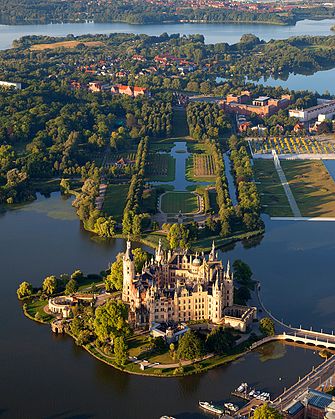
Schwerin Castle is a landmark of Mecklenburg-Vorpommern and the seat of the state parliament. It is one of over 2000 palaces, castles and manor houses in the state.

The historical districts of Mecklenburg and Western Pomerania, separated by the dashed red line. Shown are the counties since the 2011 reform.
Name
Country name
Pronunciation and usage
The word Mecklenburg is commonly pronounced [meːklənbʊɐç] or Meeklenburch in the country. The "e" is pronounced long (this is to be understood as the correct pronunciation of the "E" throughout Germany; see: CK in the north) and the "g" like a palatal "ch". The change of the "G" in the final sound is a remnant of Low German phonology.
In the Mecklenburg-Vorpommern varieties of Low German, the name form Mękelborg is used.
As an abbreviation for the name of the country is colloquially used MV.
The inhabitants of the state are referred to as Mecklenburgers or Pomeranians or Western Pomeranians, depending on the part of the state; it is unusual to refer to the state as Mecklenburg-Western Pomerania because the two parts of the state each have their own history and identity.
History of origins
The name Mecklenburg ("Mikelenburg") first appears in a document drawn by Emperor Otto III on the "Mikelburg". The document dates from 995. In Old Low German, mikil meant "big" and the name Mikilinborg ("big castle"), which originated in the 10th/11th century, refers to Mecklenburg Castle near Wismar. In the Middle Ages it became Middle Low German Mekelenborch, later German Meklenburg and Mecklenburg.
The name Pomerania is of Slavic origin. The name Vorpommern came into being relatively late (16th/17th century) as a designation for the areas of the Duchy of Pomerania lying west of the Oder River. The name Pomerania, in turn, is derived from a Slavic compound word meaning "by the sea" (see Pomerania). This political-geographical term is about as old as that of Mecklenburg. Already in 1046 the first Pomeranian prince Zemuzil is mentioned. In the further course of the Middle Ages, the term Pomerania became the main designation of the dominion of the dynasty of the Griffins.
The name "Mecklenburg-Western Pomerania" was first coined when the former state of Mecklenburg was united with the areas west of the Oder-Neisse line (with the exclusion of Stettin and Swinemünde) of the former Prussian province of Pomerania on the basis of an order issued by the Soviet military administration in early July 1945. Initially, various names circulated for the new administrative entity, including "Mecklenburg-Pomerania" and also early on, ignoring the Pomeranian parts of the state, simply "Mecklenburg." The latter designation became binding on the instructions of the Soviet occupying power as of February 25, 1947.
It was not until the reconstitution as a state with a changed territorial structure - based on the three northern districts of Rostock, Schwerin and Neubrandenburg in the GDR - in the fall of 1990 that the state was again given the name "Mecklenburg-Vorpommern".
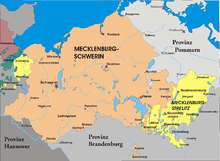
Mecklenburg-Schwerin, Mecklenburg-Strelitz and the west of the Prussian province of Pomerania as they existed from 1815 to 1934
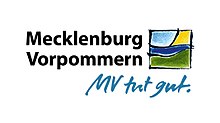
Official logo of the state of Mecklenburg-Vorpommern
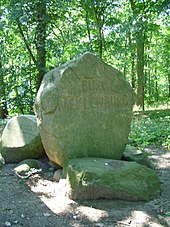
Monument to Mecklenburg Castle near Wismar
History
→ Main article: History of Mecklenburg-Western Pomerania and New Länder
For the history of the historical territories until 1945, see: History of Mecklenburg and History of Pomerania.
The state of Mecklenburg-Vorpommern was formed after the end of World War II on July 9, 1945 by the Soviet military administration from the former state of Mecklenburg, the part of Vorpommern that remained with Germany, i.e. the majority, and the former Hanoverian Amt Neuhaus. Already in 1947 the part of Vorpommern was removed from the name of the state and the territory continued to exist as the state of Mecklenburg until 1952.
As early as 1952, as part of the administrative reform in the GDR, the state was dissolved and essentially divided into the three districts of Neubrandenburg (the southeast), Rostock (the coast) and Schwerin (the southwest).
With German reunification in 1990, the new state of Mecklenburg-Western Pomerania was formed from the districts of Neubrandenburg, Rostock and Schwerin, excluding the counties of Perleberg, Prenzlau and Templin, and thus roughly corresponded to the territorial extent that Mecklenburg had had when it was dissolved in 1952. Schleswig-Holstein and the Free and Hanseatic City of Hamburg were partner states of Mecklenburg-Western Pomerania during the establishment of the new administrative structures.
Since the political turnaround, large parts of numerous cities throughout the state have been redeveloped as part of urban development funding. The historic old towns of Stralsund and Wismar were added to the UNESCO World Heritage List in 2002. Since reunification, Mecklenburg-Western Pomerania has been confronted not only with far-reaching structural change, but also with considerable demographic change. As early as 1994, the state government therefore reacted with a comprehensive district reform, which was followed by a second one in 2011.
In 2007, Mecklenburg-Western Pomerania hosted the globally important G8 summit of industrialized nations, which took place in Heiligendamm near Rostock. Since 1990, the constituency of German Chancellor Angela Merkel, who has been in power since 2005, has been in northeastern Mecklenburg-Western Pomerania; her constituency office is in Stralsund. Former Rostock pastor Joachim Gauck was German president from 2012 to 2017 and, like the chancellor, regularly held events in the state.

States of the GDR until 1950/1952 (purple), Federal States 1990 (red)
Geography
Country area
Geographically, Mecklenburg-Vorpommern belongs to northern Germany. The state of Mecklenburg-Western Pomerania includes the area of Mecklenburg, which makes up about two-thirds of the state's area, as well as the parts of the former Prussian province of Pomerania that remained with Germany after 1945 (Western Pomerania, Gartz (Oder) office excluded), small parts of the Prignitz and the northernmost tip of the Uckermark (formerly Brandenburg). Until 1950, the Fürstenberger Werder also belonged to the state territory.
Landscape
Coast and water areas
Mecklenburg-Vorpommern has a total coastline of about 2000 km, making it the longest coastline of all German states. The majority of this is taken up by bays and the Vorpommern Bodden and Haff coasts, because the coast in the eastern part of the state is particularly strongly indented by lagoons and straits. The outer coast is about 350 km long.
The two largest islands in Mecklenburg-Vorpommern, Rügen and Usedom, are also Germany's largest islands. Other larger islands are Poel (third largest in the state and seventh largest in Germany), Ummanz and Hiddensee. The most important peninsula is Fischland-Darß-Zingst. Well-known inland islands in the state include the old town island of Malchow in Lake Malchow, the castle island of Mirow and the Neubrandenburg torpedo debris island in Lake Tollense.
The state of MV is crisscrossed by rivers and canals with a total length of more than 26,000 km. With its more than 2028 lakes with a total area of 738 km², Mecklenburg-Vorpommern has a unique lake and water landscape. The Müritz is the largest lake in Germany located entirely on German territory and is part of the extensive Mecklenburg Lake District (also known as the Seenplatte). Other large lakes include Lake Plauer See, Lake Schwerin and Lake Schaalsee in western Mecklenburg, and Lake Malchiner See, Lake Kummerower See and Lake Tollensesee in the eastern part of the state. Other lake-rich areas include the Feldberg and Sternberg lakelands. In the wake of the 2011 and 2013 flood crises, a new disaster prevention advance warning system was established to better respond to crisis situations. Coastal protection plays an important role throughout the Baltic Sea region.
See also: List of water bodies in Mecklenburg-Vorpommern
Country
The landscape of Mecklenburg-Vorpommern in the North German Lowlands is characterized by the Weichselian Ice Age (Pleistocene). The landscape forms south of the coastline divide roughly from northeast to southwest:
- The northeastern lowlands comprise roughly the mainland of Western Pomerania. It has predominantly clayey soils and is less than 50 m above sea level overall. The levels of most bodies of water are even less than 10 m above sea level.
- The Baltic Ridge with the Mecklenburg Lake District stretches as a young moraine landscape from northwest Mecklenburg to southeast Mecklenburg. Large parts lie clearly more than 50 m, numerous hilltops more than 100 m above sea level. The level of the Müritz is 62.1 m, that of the Carwitzer See near Feldberg near the border to Brandenburg even 83.8 m above sea level.
- The southwestern foreland of the Lake District, i.e. the area southwest of the state capital Schwerin, is drained toward the Elbe Valley, in which Mecklenburg has held only a small share since the cession of the Neuhaus district.
The land is flat to hilly. Of the highest elevations, some belong to the Baltic Land Ridge, such as the Helpter Berge (179 m), the Ruhner Berge (176.6 m) and the Brohmer Berge (153.1 m). Others lie close to the coast, such as the Piekberg on Rügen (161 m), the Kühlung (129.7 m) northwest of Rostock and the Golm (69.1 m) on Usedom. The Warnow, Recknitz and Tollense rivers have pronounced valley landscapes, as do shorter sections of the Peene, Trebel and Großer Landgraben rivers.
With the Jasmund National Park, the Vorpommersche Boddenlandschaft National Park and the Müritz National Park, a total of three of Germany's 16 national parks are located in Mecklenburg-Vorpommern, which thus has more of these special protected areas than any other German state.
See also: Nature conservation in Mecklenburg-Western Pomerania
Climate
The climate in Mecklenburg-Vorpommern is characterized by the transition from maritime influence in the coastal area of the Baltic Sea to continental climate inland. Thus, the tendency to precipitation decreases inland. The Baltic Sea region, especially in the area of the islands of Usedom, Rügen and Hiddensee, has the highest number of sunny days in Germany.

Brohmer mountains
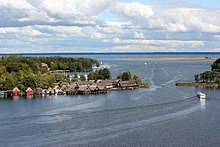
The Müritz (here near Röbel) is a part of the Mecklenburg Lake District
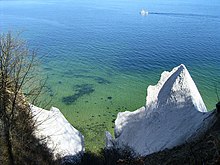
Chalk cliffs in Jasmund National Park on the island of Rügen

Relief and water bodies of Mecklenburg-Western Pomerania: terrain elevations (brown) at the elevation point, elevations of water bodies in dark blue, water bodies crossing watersheds in purple.
Administration breakdown
Counties and independent cities
→ Main article: List of counties and independent cities in Mecklenburg-Vorpommern
Since the 2011 district reform, the state has been divided into six counties and two independent cities. Since then, five of the counties have been among the largest in Germany in terms of area.
| County or independent city | Country part | County seat | Residents | Surface km² | Inhabitants per |
| Rostock | Mecklenburg | - — | 209.191 | 181,26 | 1153 |
| Schwerin | Mecklenburg | - — | 95.653 | 130,52 | 733 |
| County Ludwigslust-Parchim | Mecklenburg | Parchim | 211.779 | 4.751,86 | 45 |
| Mecklenburg Lake District | Mecklenburg | Neubrandenburg | 258.074 | 5.470,03 | 47 |
| Northwest Mecklenburg County | Mecklenburg | Wismar | 157.322 | 2.118,45 | 74 |
| Rostock County | Mecklenburg | Güstrow | 215.794 | 3.422,23 | 63 |
| County Vorpommern-Greifswald | Western Pomerania | Greifswald | 235.623 | 3.929,48 | 60 |
| County Vorpommern-Rügen | Western Pomerania | Stralsund | 224.702 | 3.207,22 | 70 |
Cities, offices and municipalities
|
| |||||||||||||||||||||||
| Upper centers Medium-sized centers |
→ Main articles: List of cities and municipalities in Mecklenburg-Western Pomerania, List of towns in Mecklenburg-Western Pomerania and List of offices in Mecklenburg-Western Pomerania.
The state of Mecklenburg-Vorpommern consists of a total of 726 politically independent cities and municipalities. These are distributed as follows: two independent cities and 724 towns and municipalities belonging to counties. Of the towns and municipalities belonging to counties, 38 are independent. The 686 towns and municipalities belonging to the administrative districts are grouped together to form 76 offices for the purpose of carrying out their administrative business (as of June 30, 2016). In addition to the four regional centers Rostock, Schwerin, Stralsund-Greifswald and Neubrandenburg, 18 cities in the state fulfill the function of a middle center for their region, see list. Furthermore, basic centers are defined in rural areas and in the urban hinterland.
Largest cities
The 25 largest cities in the country are:
| City | County | Residents |
| Rostock | county borough | 209.191 |
| Schwerin | county borough | 95.653 |
| Neubrandenburg | Mecklenburg Lake District | 63.761 |
| Stralsund | Vorpommern-Rügen | 59.418 |
| Greifswald | Vorpommern-Greifswald | 59.232 |
| Wismar | Northwest Mecklenburg | 42.963 |
| Güstrow | Rostock (county) | 29.083 |
| Goods (Müritz) | Mecklenburg Lake District | 21.057 |
| Neustrelitz | Mecklenburg Lake District | 20.128 |
| Parchim | Ludwigslust-Parchim | 17.773 |
| Ribnitz-Damgarten | Vorpommern-Rügen | 15.235 |
| Bergen on Rügen | Vorpommern-Rügen | 13.478 |
| Bad Doberan | Rostock (county) | 12.642 |
| Anklam | Vorpommern-Greifswald | 12.331 |
| Hagenow | Ludwigslust-Parchim | 12.175 |
| Ludwigslust | Ludwigslust-Parchim | 11.950 |
| Wolgast | Vorpommern-Greifswald | 11.879 |
| Boizenburg/Elbe | Ludwigslust-Parchim | 10.730 |
| Demmin | Mecklenburg Lake District | 10.564 |
| Grevesmühlen | Northwest Mecklenburg | 10.434 |
| Pasewalk | Vorpommern-Greifswald | 10.047 |
| Grimmen | Vorpommern-Rügen | 9489 |
| Sassnitz | Vorpommern-Rügen | 9186 |
| Torgelow | Vorpommern-Greifswald | 9046 |
| Barth | Vorpommern-Rügen | 8593 |

The historic market place of the Hanseatic and university town of Greifswald

Counties and independent cities in Mecklenburg-Western Pomerania
Politics
The basis of Mecklenburg-Western Pomerania's policy is the constitution of the state of Mecklenburg-Western Pomerania of May 23, 1993, which came into force on November 15, 1994.
Prime Minister
In the post-war period and the period of the GDR.
The prime ministers of Mecklenburg-Western Pomerania (1945-1947) and Mecklenburg (1947-1952) were Wilhelm Höcker (1945-1951, SPD/SED), Kurt Bürger (July 19-28, 1951, SED) and Bernhard Quandt (1951-1952, SED).
From 1952 until German reunification in 1990, Mecklenburg-Vorpommern did not exist. The territory formed the main part of the three GDR districts of Rostock, Schwerin and Neubrandenburg.
Since the restoration of the country in the Federal Republic of 1990.
From 1990 to 1992, Alfred Gomolka (CDU) was the first prime minister of the restored state after German reunification. He was succeeded by CDU politician Berndt Seite (1992-1998), who governed from 1992 to 1994 in a coalition of the CDU with the FDP and from 1994 in a grand coalition of the CDU and SPD. Harald Ringstorff (SPD), under a coalition of the SPD together with the PDS, had the longest term in office to date from 1998 to 2008. From October 2008 to July 2017, Erwin Sellering (SPD) was state premier in a red-black coalition. After the 2011 state election, Sellering began his second term in office on October 25, 2011, and finally his third term on November 1, 2016, after the 2016 state election. On May 30, 2017, he announced his resignation from all offices due to cancer.
State government
→ Main article: State government of Mecklenburg-Western Pomerania
The affairs of state in Mecklenburg-Western Pomerania are divided between the Minister President and eight ministers. Since July 4, 2017, the cabinet of the state government (Schwesig) has included:
| Office | Name | Party |
| Prime Minister | Manuela Schwesig | SPD |
| Deputy Prime Minister | Lorenz Caffier, since Nov. 2020 Harry Glawe | CDU |
| Home Affairs and Europe | Lorenz Caffier, since Nov. 2020 Torsten Renz | CDU |
| Justice | Katy Hoffmeister | CDU |
| Finance | Reinhard Meyer | SPD |
| Economy, labor, health and tourism | Harry Glawe | CDU |
| Agriculture, Environment and Consumer Protection | Till Backhaus | SPD |
| Education, science and culture | Bettina Martin | SPD |
| Energy, Construction, Infrastructure and Land Development | Christian Pegel | SPD |
| Social affairs and equality | Stefanie Drese | SPD |
In contrast to what is now common practice in many other German states, the state government has dispensed with a Minister for Europe. This office is assumed by the Minister President in personal union. She also represents the state in the Conference of European Ministers. The State Chancellery is responsible for coordinating European policy. An information office of the state of Mecklenburg-Western Pomerania at the European Union has been established in Brussels, which reports to the State Chancellery.
Landtag
See also: State elections in Mecklenburg-Western Pomerania
The Mecklenburg-Western Pomerania state parliament is the state parliament of Mecklenburg-Western Pomerania. It was constituted on October 26, 1990, twelve days after the first state election and 23 days after the reunification of Germany. It has its seat in Schwerin Castle. As the central legislative body of the state, the Landtag is responsible for electing the prime minister, passing or amending state laws, and overseeing the state government and state administration. Since 2006, the electoral period has been five years.
The last state election in Mecklenburg-Western Pomerania took place on September 4, 2016. Since then, the state parliament has been composed (by size) of the SPD, AfD, CDU and Left parties. Previously, the FDP and the NPD were represented in the state parliament twice since 1990, as well as Bündnis 90/Die Grünen once.
Local politics
See: Local Election Law (Mecklenburg-Western Pomerania), Local Politics in Germany.
County Councils
See: County council (Mecklenburg-Western Pomerania)
Federal Politics
See: Representation of the State of Mecklenburg-Western Pomerania to the Federal Government
International relations and European policy
Mecklenburg-Vorpommern maintains its own close relations with several countries; bilateral partner regions exist in Poland (Euroregion Pomerania - West Pomeranian Voivodeship/Szczecin since 2000 and Pomerania/Gdansk since 2001), the USA (Mecklenburg County in North Carolina since 1994), Finland (Turku Region since 2000), Russia (Leningrad Oblast since 2002), and France (Poitou-Charentes since 2003). Since 2013, a partnership has been established with the three northern provinces of the Netherlands Groningen, Friesland and Drente. Intensive relations are also established with Austria and Switzerland in the 2010s. The state also hosts numerous conferences and trade fairs with participation from all over the world, especially in maritime, tourism, cultural, agricultural, as well as medical and other technological fields, which is supported by the state government. Several cities of the state are involved in the transnational association of cities called New Hanseatic League.
Mecklenburg-Western Pomerania will be represented by five Members of the European Parliament (MEPs) in the 2014-2019 legislative period: Werner Kuhn (CDU), Iris Hoffmann (SPD), Reinhard Bütikofer (Bündnis 90/Die Grünen), Helmut Scholz (Die Linke) and Arne Gericke (Familien-Partei Deutschlands). The state maintains an information office in Brussels and an online Europe portal.
Direct democracy
See: Direct democracy in Mecklenburg-Western Pomerania
Dishes
See: List of courts in the state of Mecklenburg-Western Pomerania, Court Structure Act and Court Structure Reform.
Coats of arms and flags
→ Main article: Coat of arms of Mecklenburg-Vorpommern and flag of Mecklenburg-Vorpommern
|
|
|
|
|
| Large national coat of arms | Small national coat of arms | Country flag | National service flag |
|
|
|
|
|
| Mecklenburg state flag | Bull head from | State flag of Vorpommern | Griffin for |

The State Chancellery in Schwerin, seat of the Minister President.
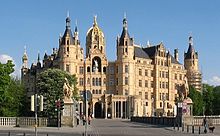
Schwerin Castle is the seat of the state parliament.
Economy
In the industrial sector, the maritime industry, mechanical engineering, the energy industry and the food industry have a large share. Agriculture is very present in the area. In addition, tourism, the health sector, the real estate industry, service companies and high technology are playing an increasingly important role in the economy of Mecklenburg-Vorpommern.
Industries of the future
Knowledge-based fields of cutting-edge technology, especially biotechnology, life sciences and medical technology, energy and environmental technology, aerospace technology and information technology (IT for short) are considered to be the industries of the future in Mecklenburg-Vorpommern. Companies from these fields are increasingly settling around the cities of Rostock and Greifswald with their high-performance universities, as well as around the university locations of Stralsund, Wismar, Schwerin and Neubrandenburg and their technology centers. The centers as well as several initiatives primarily promote innovative start-ups, e.g. the Entrepreneurs Club Rostock, Gründungswerft Greifswald, Wismars Entrepreneurs, Gründer MV, IT-Lagune Vorpommern, IT-Initiative MV, Kreative MV and BioCon Valley.
In addition, numerous research institutes have already settled around the state's two traditional universities, the University of Rostock (founded in 1419) and the University of Greifswald (founded in 1456) (see Research). The state's science locations contribute significantly to cultural and economic development and to raising the state's global profile.
Industrial sector
Maritime economy
The maritime industry in MV with its shipbuilding and boatbuilding sectors as well as maritime suppliers and service providers including marine and offshore technology is an essential industrial core and therefore of extraordinary economic and employment policy importance for the state. Approximately 11,500 employees in the nearly 300 companies generate sales of around 1.5 billion euros.
Larger companies in the maritime economic sector are, for example, the globally operating Deutsche Seereederei, Scandlines, Mecklenburger Metallguss (MMG), Weiße Flotte and Liebherr (maritime cranes and equipment). The cruise company AIDA Cruises has its German headquarters in Rostock's city port and employs more than 8000 people, making it the largest company in Mecklenburg-Vorpommern.
There are several shipyards along the Baltic coast, the largest being in Rostock-Warnemünde, Wismar, Stralsund (MV Werften/Genting) and in Wolgast (Peene Werft/Lürssen).
There are also medium-sized shipbuilders such as HanseYachts AG in Greifswald (one of the three largest yacht builders in the world), Vilm Yachts in Lauterbach, Yachtbau Oelke in Marlow, the Rammin shipyard and Schiffswerft Barth GmbH in Barth, Bootsbau Schubert in Plate, MoLe Bootsbau in Plau, Wieker Boote GmbH in Wiek and REAN GmbH in Sassnitz.
The "Future Conference of the Maritime Industry" is held every two years in Rostock.
Aerospace
Mecklenburg and Western Pomerania have a significant history in the aerospace industry. Since German reunification in 1990, the industry has been able to develop again in the state. Since then, aerospace companies have settled in the Rostock area and at Rostock-Laage Airport, including several Airbus suppliers with a total of around a thousand employees, such as RST Rostock-System-Technik GmbH. Edag, luratec AG, Assystem, Ferchau Engineering and Diehl Aerospace are also located in Rostock. In November 2007, the Warnemünde Aerospace Center was opened. Furthermore, there is the Competence Center for Aircraft Development and Construction in Pasewalk in the greater Szczecin area, where the light aircraft designer REMOS AG has settled. The German Aerospace Center (DLR) maintains facilities of the German Remote Sensing Data Center and the Institute for Communication and Navigation in Neustrelitz. The Neustrelitz researchers are significantly involved in the development of the European satellite navigation system Galileo. The magazine Raumfahrt Concret (Spaceflight Concret), which is distributed in German-speaking countries, is published from Neubrandenburg. Together with several partners, it organizes the annual "Spaceflight Days" there and at other locations in the state, which are also attended by renowned scientists and astronauts from all over the world who come to Mecklenburg-Vorpommern.
In GDR times, practically all companies in the industry were expropriated from 1961 at the latest and converted to agricultural production, for example, or completely liquidated. In the pre-war period, however, numerous inventions and companies were born in the region. The important astronomer Tycho Brahe studied at the University of Rostock in the 16th century. Otto Lilienthal from Anklam was the most important German aviation pioneer and launched the world's first serial aircraft, the Normalsegelapparat, in 1894. Fokker Aeroplanbau GmbH, which moved from Berlin to Schwerin in 1913, had its headquarters directly on Schwerin Lake in Bornhövedstrasse; the aircraft construction company became world-famous for its triplanes with the "Red Baron", among other things.
One of the largest aircraft manufacturers of the first half of the 20th century, Ernst Heinkel Flugzeugwerke, was founded in Rostock-Warnemünde in 1922. The Heinkel He 178 was the world's first jet aircraft and made its maiden flight in Rostock-Marienehe on August 27, 1939. From 1921, Warnemünde was also home to the Arado aircraft factory. Also based initially in Warnemünde and from 1934 in Ribnitz was Walther-Bachmann-Flugzeugbau. For the rearmament policy from 1933 on, most of the companies were expropriated or had to switch to military production. From 1933 to 1945, the Norddeutsche Dornier-Werke in Wismar, with a later branch in Neustadt-Glewe, was completely shut down for war production.
Also committed to military rearmament, the Peenemünde Army Test Facility was established in 1936 on the western side of the island of Usedom, and the Luftwaffe's West Plant was added in 1938. At the facilities, the first operational large rocket, Aggregat 4 (A4, propaganda name "V2"), was developed and tested under the direction of Wernher von Braun and Walter Dornberger. With its first successful flight on October 3, 1942, the rocket was the first man-made object to enter the frontier of space. Thus, despite the inhumane circumstances of rocket production with thousands of deaths in Mittelbau-Dora, Peenemünde is considered the cradle of space travel. The world's first facility for industrial television was also set up there to broadcast rocket launches. At the same time, large rockets were tested on the Zingst peninsula. Many of the V2 engineers at Peenemünde became high-ranking developers at the U.S. space agency NASA after World War II; for example, in addition to technical director Wernher von Braun, Arthur Rudolph, among others, participated in the Apollo program for the first moon landings. Other participants, such as Helmut Gröttrup, switched to the Soviet space program during the space race.
See also: German space travel
Energy sector
Mecklenburg-Vorpommern is among the leaders in Germany in the field of renewable energies, both in terms of electricity production and the manufacture of wind turbines and photovoltaic systems. In an average wind year, about 46% of the state's electricity needs can already be met by wind power. In Mecklenburg-Vorpommern, there were 1819 wind turbines with an installed capacity of 3008 megawatts in mid-2016. There are several offshore wind farms off the coast of Mecklenburg-Vorpommern (EnBW Baltic 1 and Baltic 2), and others are under construction or in planning. Rostock is home to Nordex SE, a manufacturer of wind turbines. Decentralized biogas plants and photovoltaic systems also play a major role in environmentally compatible energy production. There are solar module factories in Greifswald and Wismar. The first pilot project of a geothermal power plant in the former GDR is the Neubrandenburg Geothermal Heating Plant, which has been in use since the late 1980s and was expanded to a long-term deep storage facility in 2004.
The Nord Stream pipeline from Vyborg in Russia, built by a Russian-German-Dutch consortium, arrives near Greifswald to supply Germany and Western Europe with Russian natural gas. Larger power plants in Mecklenburg-Western Pomerania are the Rostock and Schwerin-Süd power plants. The former largest electricity producer on the state's territory was the Lubmin nuclear power plant, which is now decommissioned. Two projects for power plants also planned in Lubmin, a coal-fired power plant and a gas-and-steam combined cycle power plant, have been discontinued.
· 
Electricity energy mix in MV
· .png)
Distribution of wind turbines in MV
Tourism
→ Main article: Tourism in Mecklenburg-Western Pomerania
See also: List of seaside resorts, spas and resorts in Mecklenburg-Vorpommern
Mecklenburg-Western Pomerania is the most popular domestic destination in Germany. Since 2012, Mecklenburg-Western Pomerania has had the highest growth in international overnight visitors to Germany in each year.
The islands of Usedom, Rügen and Hiddensee in the state of Vorpommern are focal points of tourism in Germany, as are the Fischland-Darß-Zingst peninsula and the Mecklenburg seaside resorts such as Heiligendamm, Graal-Müritz and Kühlungsborn with their spa architecture. In addition, the historic Hanseatic cities of Stralsund, Greifswald, Rostock (with Warnemünde) and Wismar with their important old towns as well as the Mecklenburg residential towns of Güstrow, Ludwigslust and Schwerin with their castles, and main towns of the lake district such as Neustrelitz, Neubrandenburg, Malchow, Mirow, Röbel and Waren (Müritz) are important attractions. The historic old towns of Stralsund and Wismar have been UNESCO World Heritage Sites since 2002. In addition, there are numerous other historic town centers worth seeing with brick Gothic churches, town houses, fortifications and town gates as well as other architectural monuments. Several vacation routes lead through the state.
For nature lovers, anglers and water sports enthusiasts, the Mecklenburg Lake District and the Müritz National Park are important inland. Along the coast, the Jasmund National Park with the famous chalk coast off Rügen and the Vorpommersche Boddenlandschaft National Park with its lagoons are among the attractions. Furthermore, there are countless different landscape and nature reserves.
In Mecklenburg and Western Pomerania there are more than two thousand manor houses, castles and palaces (e.g. Kalkhorst Castle, Granitz Hunting Lodge, Basedow Castle, Bothmer Castle, Stargard Castle), which are used for cultural events or as hotels, among other things. In addition, there are many other sights in the rural area, such as historic village centers, churches, monasteries, windmills, lighthouses, evidence of Slavic settlement, monuments and viewpoints.
Rostock's Warnemünde district is the cruise port with the highest number of passengers in Germany. The Warnemünde Week, which takes place every summer in Warnemünde, and the Hanse Sail attract more than one million tourists to Rostock every year. In addition, the Müritz Sail in Waren (Müritz) has established itself as an event on inland waterways.
Tourism in MV is also of great importance outside the summer season, and business in the off-season and winter is growing steadily. On cool days, indoor offerings such as the numerous museums, theaters, shopping and leisure pools are often taken advantage of. In the winter months, visits to the traditional Christmas markets (especially in Rostock, Schwerin, Stralsund, Neubrandenburg and the seaside resorts) as well as New Year's Eve and wellness arrangements are popular.
Key figures of the economy
The gross domestic product (GDP) was 42.8 billion euros in 2017. Overall, Mecklenburg-Western Pomerania generated 1.3 percent of Germany's total economic output. The service sector accounted for 76.2 percent of Mecklenburg-Western Pomerania's gross value added, while the manufacturing sector generated 21.6 percent. In 2019, the gross domestic product (GDP) per capita in Mecklenburg-Western Pomerania was 28,940 euros, just under 83% of the average value within the EU member states. In terms of the purchasing power index, Mecklenburg-Western Pomerania also ranked last in Germany with 83.1 (2019). In terms of the wealth ratio, Mecklenburg-Western Pomerania ranked second to last among the German states in 2019, ahead of Saxony-Anhalt with 3.6% (national average:7.9%).
The state budget has been balanced or positive since 2006, meaning that no new debt has been incurred for ten consecutive years. The state plans to have a balanced budget by 2020, and a total of 900 million euros in debt was repaid between 2006 and 2015.
The unemployment rate in the Mecklenburg-Western Pomerania region rose from 1990 to as high as 20 percent (September 2004) and then fell steadily to 7.6 % in December 2018, its lowest level since 1990. Regional differences are particularly evident between the western counties of Ludwigslust-Parchim (5.5%), Rostock (5.6%), and Northwest Mecklenburg (6.1%) on the one hand, and the more southeastern counties of Vorpommern-Greifswald (9.2%), Mecklenburgische Seenplatte (9.1%), and Vorpommern-Rügen (9.5%) on the other (as of December 2018). Mecklenburg-Vorpommern still has the lowest wages in all of Germany. One in three earns no more than 2000 euros gross despite having a full-time job. In 2017, the median monthly gross pay of employees subject to social security contributions was 2,391 euros, compared to the West German average of 3,339 euros.
The top ten locations of employment subject to social insurance contributions are (work location data):
| City | socially insur. Employees30 | Changesince30 | Commuter | Job density12 |
| Rostock | 92.514 | +7,27 | +11.512 | 691 |
| Schwerin | 50.834 | +3,24 | +15.107 | 868 |
| Neubrandenburg | 33.978 | +3,8 | +10.406 | 862 |
| Greifswald | 28.716 | +6,88 | +5.074 | 720 |
| Stralsund | 25.767 | +10,25 | +5.340 | 706 |
| Wismar | 18.604 | +6,15 | +3.094 | 712 |
| Güstrow | 12.915 | +1,23 | +2.397 | 735 |
| Goods (Müritz) | 10.849 | +5,02 | +2.905 | 883 |
| Neustrelitz | 9.387 | +2,24 | +1.837 | 783 |
| Parchim | 9.354 | +0,6 | +2.971 | 891 |
1 Jobs subject to social security contributions per 1,000 inhabitants of working age 15 to under 65; figures as of December 31, 2018, according to the update of the population status pursuant to the Population Statistics Act based on the 2011 census.
2 Own calculation
| Development of the unemployment rate | ||||||||||||||||||||
| Year | 2000 | 2001 | 2002 | 2003 | 2004 | 2005 | 2006 | 2007 | 2008 | 2009 | 2010 | 2011 | 2012 | 2013 | 2014 | 2015 | 2016 | 2017 | 2018 | 2019 |
| Unemployment rate in % | 17,8 | 18,3 | 18,6 | 20,1 | 20,4 | 20,3 | 19,0 | 16,5 | 14,1 | 13,5 | 12,7 | 12,5 | 12,0 | 11,7 | 11,2 | 10,4 | 9,7 | 8,6 | 7,9 | 7,1 |
Further
Birthplace of the department store
Historically, the parent companies of the first large German department store chains such as Karstadt (founded in 1871 in Wismar), Kaufhof (founded in 1879 in Stralsund) and Wertheim (founded in 1875 in Stralsund) were established in Mecklenburg and Western Pomerania.
Creative Industries
The cultural and creative industries are becoming increasingly important in Mecklenburg-Vorpommern today, i.e. entrepreneurial cultural creation, e.g. by filmmakers and other artists (can be seen at the Filmkunstfest, among others), festivals and concerts and other events, theater (e.g. Störtebeker Festival), fashion and design (e.g. Fashion Week Warnemünde and LOOK Schwerin).
Real Estate
The real estate market and the construction industry are of great local importance in Mecklenburg-Vorpommern. There is high demand in scenic locations such as on the coasts and in lake areas, as well as in historic old towns and villages. Here, according to the state development program, development is to be concentrated in the inner areas of municipalities in order to utilize existing infrastructure and avoid urban sprawl in the countryside. Overall, in 2013, for the first time since 1990, there were more in-migrants than out-migrants in the state. Places with good infrastructure are seeing more frequent in-migration, especially in the outlying areas of the metropolitan regions of Hamburg, Berlin and Szczecin and in the regiopolitan region around Rostock. The state's numerous castles and stately homes have also been the focus of regional and real estate development for several years.
Food industry
Food processing is an important economic factor in the state. Examples from the food industry include potato processing by Pfanni in Stavenhagen, the Nestlé plant in Schwerin and the Oetker Group's frozen food production in Wittenburg. Trolli confectionery from Hagenow and Grabower confectionery are also known beyond the state's borders.
There are several small and a few large breweries in the state that are well known throughout Germany and beyond, the largest and best known being the Mecklenburgische Brauerei Lübz, the Störtebeker Braumanufaktur in Stralsund, the Hanseatische Brauerei Rostock and the Darguner Brauerei. There are also smaller specialty and craft breweries with a national reputation, such as the Mecklenburg Vielanker Brauhaus, the Barther Spezialitätenbrauerei, the brewery in the Mellenthin moated castle on Usedom, and the Rügener Insel-Brauerei in Rambin.
State Marketing
Since 2004, the state government has been promoting Mecklenburg-Western Pomerania as a business location and living environment with the slogan "MV tut gut. When passing the state's borders on the trunk roads, Mecklenburg-Western Pomerania is advertised as a "Land to live in. The aim of the state marketing campaign is to raise awareness of Mecklenburg-Western Pomerania's strengths and potential and link them to the key areas of health, nutrition, tourism, culture, science, technology and education that are important for the state.

Cereal fields at the Baltic Sea near Boltenhagen
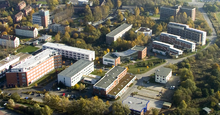
Technology Campus in Rostock-Warnemünde (TZW)
_3.JPG)
MV shipyard and Rügen bridge at the port of Stralsund
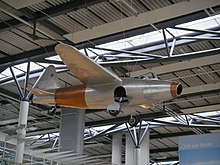
Replica of the Heinkel He 178 at Rostock-Laage Airport. The world's first jet aircraft made its maiden flight over Rostock-Marienehe on August 27, 1939.
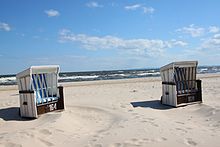
The beach chair is considered a symbol of tourism in Mecklenburg and Western Pomerania, especially on the Baltic coast (here Ahlbeck on Usedom). There are numerous seaside resorts, spas and resorts in the country.

Lighthouse Dornbusch on the car-free island Hiddensee
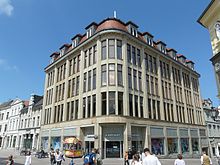
Karstadt flagship store, founded in Wismar in 1871

Beer garden of the Störtebeker brewery in Stralsund
Traffic
Railroad
The Berlin-Hamburg railroad runs through the southwestern landscape of Mecklenburg-Vorpommern. Branching off from this line are connections via Schwerin and the Bad Kleinen to Wismar and again from Bad Kleinen to Rostock (continuation in the direction of Stralsund-Rügen). Other main lines run north-south from Berlin via Neustrelitz to Rostock/-Neubrandenburg-Stralsund and from Berlin via Pasewalk-Anklam-Greifswald to Stralsund. The Bützow-Stettin railroad line forms an almost 200 km long west-east cross connection in the interior of the state. In addition, there are various branch lines branching off from the main lines and a suburban rail network in Rostock.
In recent years, a considerable number of rail lines and rail infrastructure (especially many branch lines and smaller stations as well as sidings) have been closed and mostly dismantled. The country experienced extensive cuts in local rail passenger transport (SPNV), for example, in December 2012, when a larger number of lines were canceled or thinned out. At larger stations, too, tracks were and are being cut back and operations greatly simplified as part of modernization measures. Considerable personnel savings have been made through automation (of level crossings, among other things). There are now sections of track over 20 km long without intermediate stops (e.g., on the RE 5), as only long-distance regional express (RE) lines operate there.
The largest and most efficient rail transport company in Mecklenburg-Vorpommern is DB Regio AG, which provides most of the local rail passenger transport (SPNV). On some secondary lines in the Vorpommern region, SPNV is successfully operated by the Deutsche Bahn subsidiary UBB. One non-federally owned railroad company worth mentioning is ODEG, which operates three regional railroad lines in the West Mecklenburg region.
Well-known historical narrow-gauge railroads in the state are the Rasende Roland on the island of Rügen and the Molli seaside railroad in the Rostock district. Other tourist narrow-gauge railroads include the Mecklenburg-Pomeranian Narrow-Gauge Railway in Galenbeck-Schwichtenberg and the Klützer Coffee Distiller near Boltenhagen.
See also: List of passenger stations in Mecklenburg-Vorpommern and Category:Railway line in Mecklenburg-Vorpommern
Public transport
The most extensive public transport system in the state is in the Hanseatic city of Rostock. This is coordinated by the Warnow Transport Association (VVW).
In the state, there are both municipal transport companies with their own buses - such as MVVG - and private operators. The route network is mostly well developed in the major and medium-sized centers, while buses run less frequently in smaller towns. In addition to local transport operators, there are also coach providers, and since the opening of the market in 2013, several long-distance bus lines. These include VVG's "schnurstracks" connection between Greifswald and Neubrandenburg, as well as several lines between Berlin, Hamburg, Neubrandenburg, Rostock, Schwerin and the vacation resorts operated by providers such as UBB and Flixbus, which travel to many major cities in Germany. The southeast of the state is connected to Szczecin by bus lines operated by VVG.
Standard-gauge streetcars exist in the Hanseatic city of Rostock and in the state capital Schwerin. The Stralsund tramway was operated from 1900 to 1966.
See also: Category:Public transport (Mecklenburg-Vorpommern)
Street
Mecklenburg-Western Pomerania is served by the A 20 freeway from Lübeck via Wismar, Rostock and Neubrandenburg to the Uckermark triangle, the A 24 from Hamburg to Berlin with connections via the A 14 to Schwerin and Wismar, and the A 19 from Berlin to Rostock, and in the extreme southeast by the A 11 (Berlin-Stettin).
Various federal highways crisscross the state, the most important north-south connection being the B 96, while in the east-west direction there are the B 104, B 105 (following the former Hansische Ostseestraße), the B 110 and the B 192.
Several vacation routes in Mecklenburg-Vorpommern have been designated for tourist use.
See also: Category:Street in Mecklenburg-Western Pomerania
Shipping
Important seaports are located in Rostock, Wismar and Sassnitz (Port Mukran) on Rügen, others are in Stralsund, Greifswald, Wolgast, Lubmin, Ueckermünde and Vierow. Ferry lines run from the Rostock overseas port and the Sassnitz ferry port to Denmark, Sweden, Finland, Poland and the Baltic States. In 2017, around 3.6 million passengers embarked and disembarked on ferries and cruise ships in MV's ports, including almost 3.2 million in Rostock alone. In 2013, a good 1.9 million ferry passengers were transported via Rostock's ports. In 2017, the ports of Mecklenburg-Vorpommern handled around 27 million tons of goods, of which 20.4 million tons were handled in Rostock, 3.2 million tons in Wismar, 1.5 million tons in Sassnitz and 0.97 million tons in Stralsund. In 2015, the combined total was 39.52 million tons, of which 15.3 million tons were in RoRo traffic and 4.1 million tons were general cargo.
Rostock's Warnemünde district was the largest cruise port in Germany with 181 cruise ship calls and over 766,000 passengers handled in 2016.
There are sailing and sports boat marinas in many coastal towns. In addition to the larger towns on the waterfront, the largest marinas are located in Lubmin, Niendorf, Darß, Prerow, Born, Glowe, Neuhof, Lauterbach/Putbus, Kröslin, Karlshagen, Mönkebude and Ueckermünde. The many lakes in the hinterland are connected to each other and to the Baltic Sea via the Warnow, the Recknitz, the Peene and various canals for shipping. Particularly in the Mecklenburg Lake District, there are a large number of recreational boat harbors. In Greifswald there is a museum harbor with historic ships.
Air traffic
Mecklenburg-Vorpommern is home to one major airport, four medium-sized regional airports (where aircraft up to the size of the Airbus A320 can land), and numerous smaller airfields and runways. By far the largest and busiest airport is Rostock-Laage Airport. In recent years, it has gained in importance as a feeder for cruise tourism, for vacation flights, as well as for business flights in German-speaking countries.
Regional airports are Heringsdorf Airport on Usedom, Neubrandenburg Airport, Barth Airport and Schwerin-Parchim Airport. They were created from former air bases of the NVA and the air forces of the Soviet Union. Schwerin-Parchim Airport will be developed into a logistics hub starting in 2014 and is also scheduled to offer scheduled flights to and from China starting in 2016. [obsolete]
Furthermore, there are numerous smaller airfields, for example the Rügen airfield near Bergen, Anklam airfield, Müritz Airpark near Röbel, Wismar airfield, Peenemünde airfield on Usedom, Rerik airfield, Pasewalk airfield, Tutow airfield, Waren/Vielist airfield, Purkshof airfield near Rostock, Schmoldow airfield near Greifswald, Pinnow airfield near Schwerin, Güstrow airfield or the Neustadt-Glewe airfield, where primarily sport aviation is practiced. This is coordinated by the Luftsportverband MV.
The international airports in Szczecin-Goleniów, Hamburg and Berlin airports, which are close to the border, also play a role for the country.
Bike
The cycling infrastructure in Mecklenburg-Vorpommern was greatly expanded after 1990, but is still very patchy. Often, only the major vacation routes are well developed, including the Berlin-Copenhagen Cycle Route, the Berlin-Usedom Long Distance Cycle Route, the Mecklenburg Lake District Ice Age Route, the Hamburg-Rügen Long Distance Cycle Route, the Mecklenburg Lakes Cycle Route, the Oder-Neisse Cycle Route, the Baltic Sea-Upper Bavaria Route (D11) and the Baltic Sea Coastal Route (D2).

The Berlin-Hamburg railroad runs through the southwest of the country.
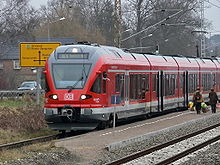
Hanse-Express in Gelbensande (railroad line Stralsund-Rostock)

The VVW line network in local transport in the Rostock conurbation (2017). In addition to the S-Bahn and streetcar, other modes of transport operate.
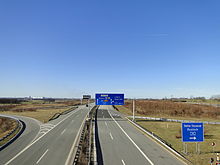
Wismar interchange linking the A 14 and A 20 freeways
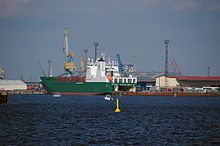
Rostock seaport
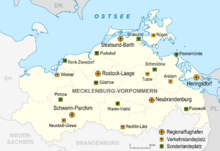
Airports and landing fields in Mecklenburg-Vorpommern
Education and research
Schools
See also: List of schools in Mecklenburg-Vorpommern and School system in Germany
According to data from the Mecklenburg-Vorpommern Statistical Office, in 2015 there were a total of 143,146 students at general education schools, 32,545 students at vocational schools and 12,429 full-time teachers in the state.
Mecklenburg and Western Pomerania have some of the oldest schools in the German-speaking world on their territory. The oldest of these is the Güstrow Cathedral School, founded in 1236 as a collegiate school to educate the next generation of clerics, and reestablished in 1552 as a Latin school, and later as a Gymnasium. Also the Lilienthal Gymnasium Anklam (1535), the Große Stadtschule Wismar (1541), the Albert Einstein Gymnasium Neubrandenburg (1553), the Fridericianum Schwerin (1553), the Jahn Gymnasium Greifswald (1561), the Parchim Friedrich Franz Gymnasium (1564), the Große Stadtschule Rostock (1580), the Niels-Stensen-Schule Schwerin (1735), the Gymnasium Carolinum Neustrelitz (1795) and the Pädagogium Putbus (1836) can point to an exceptionally long history. The humanistic Gymnasium Stralsund, founded in 1560, was not reopened after Stralsund was captured by the Red Army on May 1, 1945.
At the secondary level, there are regional schools (formerly Hauptschule or Realschule) in addition to the traditional Gymnasium. There are also a few comprehensive schools, especially in the larger cities. In order to enable a later school career decision and longer joint learning, pupils transfer together to a regional school after elementary school (grades 1-4). After the sixth grade, they can then transfer to a Gymnasium and obtain the Abitur (high school diploma), or they can obtain the Berufsreife (vocational maturity) or the mittlere Reife (intermediate maturity) at the regional school. Since 2008, the Abitur after the twelfth grade, which was the norm before 2001, has been reintroduced at all Gymnasien. In addition, the increase in the decision-making autonomy of individual schools has been continuously tested with model experiments (e.g., independent school) and increased with legislative reforms. The European School model promotes intercultural cooperation, an example of which is the Löcknitz German-Polish Gymnasium.
In addition to the state schools, there are also several privately run schools by private non-profit sponsors, some of which are also denominationally affiliated, such as the Catholic Bernostiftung, or other private schools such as the Schloss Torgelow boarding school near Waren.
Overall, the number of schoolchildren has declined since 2000. In 2009, there were about eight pupils per 100 inhabitants in Mecklenburg-Western Pomerania. In urban centers such as Rostock, Schwerin, Greifswald, Stralsund, Wismar, Neubrandenburg and other places that are attractive to families, the number of schoolchildren has again been rising steadily in recent years as a result of rising birth rates and new arrivals.
Universities
See also: Universities in Mecklenburg-Vorpommern
According to data from the Mecklenburg-Vorpommern Statistical Office, in 2015 there were a total of 38,541 students at higher education institutions in the state, including 24,625 at universities, and a total of 15,576 university employees.
State universities in addition to the universities are the Rostock University of Music and Theatre, the Neubrandenburg University of Applied Sciences, the Stralsund University of Applied Sciences and the Wismar University of Applied Sciences, the University of Applied Sciences for Public Administration, Police and Administration of Justice in Güstrow and a campus of the University of the Federal Employment Agency in Schwerin. The private Fachhochschule des Mittelstands (formerly Baltic College) has campuses in Schwerin and Rostock. Study programs are also available at the private Schwerin Design School.
Universities
There are two full universities in Mecklenburg-Vorpommern. The University of Greifswald (founded in 1456) and the University of Rostock (founded in 1419) are the two oldest universities in northern Europe and among the oldest universities in the world. Neither of them has yet been included in the federal government's Excellence Initiative.
· Universities in MV
· 
University of Greifswald
· 
University of Rostock
·
HMT Rostock
· 
HS Neubrandenburg
· 
Stralsund University
· 
HS Wismar
Research facilities
There are numerous non-university research institutes in the state, mainly concentrated in and around the universities in Greifswald and Rostock, dealing primarily with medicine, biology, physics, space travel, animal health, agricultural sciences and demography. Major institutes include the Max Planck Institute for Demographic Research, Fraunhofer IGD, the Leibniz Institute for Farm Animal Biology, the Leibniz Institute for Baltic Sea Research, the Leibniz Institute for Atmospheric Physics and the Leibniz Institute for Catalysis in Rostock, the Max Planck Institute for Plasma Physics in Greifswald and the German Aerospace Center with branches in Neustrelitz.
Several important institutes of medical research are located in the state, such as the DZNE for Nervous Diseases, the Fraunhofer Institute for Cell Therapy and Immunology, and the Heart and Diabetes Center MV at the Karlsburg Clinic. The Friedrich Loeffler Institute, a national research institute, is located on the island of Riems, which belongs to Greifswald. Well-known research results from MV include, for example, the invention of the water scalpel, also known as the Helix-Hydro-Jet, or the first artificial liver for children.
See also: Category:Science in Mecklenburg-Vorpommern

The Gymnasium Carolinum in Neustrelitz
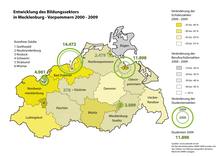
Education in MV, 2000-2009

Wendelstein 7-X fusion research project in Greifswald
Population
Around 1.6 million people live in Mecklenburg-Vorpommern today (as of December 31, 2019). The population is made up of Mecklenburgers and Pomeranians and, to a small extent, Brandenburgers. In addition, there were many expellees after World War II, mainly from eastern Pomerania and East Prussia, as well as immigrants from other regions of Germany and their descendants, historically mainly from the territory of the former GDR, and after reunification Russian-German repatriates or ethnic German immigrants. In 2014, the largest group of citizens of foreign origin came from Poland (16 percent), followed by Russia (9 percent), Ukraine (7 percent) and Vietnam (as of November 2013). Since 2015, due to the waves of refugees caused by the Syrian Civil War, the largest group is from Syria (by 20 percent). The share of the total foreign population in the country's population is 4 percent (as of September 2016).
The influx of nearly one million expellees, officially called "resettlers" in the SBZ/DDR, caused the population to soar to 2.1 million in 1945/1946. Since reaching this peak, the population has declined steadily. About eight percent of the displaced persons who reached the four occupation zones by 1950 settled in Mecklenburg-Vorpommern and accounted for up to 45 percent of the total population there.
The substantial population loss after 1989 (between 1990 and 2013: -17%) is a result of westward migration and a slump in birth rates. These trends have slowed or stopped in the 2010s; more people are migrating again and more children are being born. As of 2008, for example, the state had the highest birth rate increase in Germany, with the birth rate rising from 1.36 to 1.41. In addition, a trend toward multiple-child families is foreseeable in 2015; the probability of childbearing is higher among families that already have one child. Policymakers attribute the increases to good daycare provision, increased efforts in early childhood education, the improved labor market situation and the generally improved quality of life in the country, among other factors. Overall, it is apparent that the peripheral rural areas with poor infrastructure remain sparsely populated, while the urban centers and places with attractive landscapes and infrastructure are once again gaining inhabitants. Overall, in 2013, for the first time since 1990, Mecklenburg-Western Pomerania saw more people moving into the state than moving out. Until 2016, the state recorded positive net migration, which was reduced by a steady surplus of the number of deaths over the number of live births, thus a negative natural population balance, so that in 2016 the state again experienced a declining population level. A 2019 study by the Berlin Institute sees Mecklenburg-Vorpommern in a "demographic[n] intermediate peak" and expects a further sharp decline of 11.1% to 1.43 million inhabitants by 2035 due to high aging and low numbers of potential parents.
Mecklenburg-Vorpommern is the most sparsely populated and most rural German state. The majority of the population lives along the Baltic coast, while the south and inland areas in the east of the state are particularly sparsely populated. The Hanseatic city of Rostock, with a population of about 206,000, is the only major city in the state and is considered a regional center. Rostock is also the largest of the state's four regional centers, followed by Stralsund and Greifswald (combined population of about 115,000, as of June 30, 2016), the state capital Schwerin (population of about 95,000) and the city of Neubrandenburg (population of about 64,000). All other cities have fewer than 50,000 inhabitants; the most significant cities in this group are the Hanseatic cities of Wismar and Güstrow, as well as Waren (Müritz), Neustrelitz and Parchim. The Polish port city of Szczecin, with a population of over 400,000, now acts as a growth engine for eastern Mecklenburg-Vorpommern, especially in its metropolitan area. For the southern parts of the state, the proximity to Berlin has an advantageous effect; western Mecklenburg is integrated into the Hamburg metropolitan region and the interlinked area with Rostock and Lübeck and is also recording growth.
Average life expectancy in 2015/17 was 78.6 years for men and 83.0 years for women. Men thus ranked 15th among the German states, while women ranked 8th. Regionally, the city of Rostock (expectation of total population: 80.84 years), Rostock County (80.23) and Mecklenburg Lake District (80.04) had the highest life expectancy in 2013/15, and Ludwigslust-Parchim (79.78), Schwerin (79.76) and Vorpommern-Greifswald (79.23) had the lowest.
Religion
In 2020, the state of Mecklenburg-Western Pomerania was one of nine German states in which the share of the two major churches in the population is below 50 percent. These were the six eastern states and three northern states (Hamburg since 1995, Bremen since 2014 and Schleswig-Holstein since 2019).
Christianity
The Protestant parishes in the Northern Church are divided into the "Kirchenkreis Mecklenburg" and the "Kirchenkreis Pommern". Mecklenburg's Catholics belong to the Archdiocese of Hamburg, while the Catholics in Western Pomerania belong to the Archdiocese of Berlin.
In addition, there are congregations of the Evangelical Reformed Church in the EKD, the Independent Evangelical Lutheran Church and the Protestant free churches such as the Baptists, Free Evangelical Congregations, Methodists, Mennonites or Seventh-day Adventists. In addition, there are several smaller Christian churches such as the New Apostolic Church or the Church of Jesus Christ of Latter-day Saints (Mormons).
Other
In Mecklenburg-Western Pomerania, there is one Jewish community each in the state capital Schwerin (including Wismar) and in Rostock. Both communities are organized in the State Association of Jewish Communities in Mecklenburg-Western Pomerania, which is a member of the Central Council of Jews in Germany. The list of synagogues in Mecklenburg-Western Pomerania provides information about historical synagogues.
Islam is represented by two mosques (in Schwerin and Rostock).
Denomination statistics
The majority of the inhabitants of Mecklenburg-Vorpommern are non-denominational. According to the 2011 census, 17.2% of residents were Protestant, 3.3% Roman Catholic, and 79.5% were nondenominational, belonged to another religious community, or did not specify. A decrease in the number of Protestants contrasts with a slight increase in the number of Catholics. At the end of 2019, Mecklenburg-Vorpommern had 1,608,138 residents of which 14.5% were Protestant, 3.4% Catholic, and 82.1% had either another religious affiliation or none at all. In the previous year, 14.8% (as of December 2018) were members of the Evangelical Lutheran Church in Northern Germany (abbreviated to "Northern Church").

Population Development of Mecklenburg-Western Pomerania from 1939 to 2003
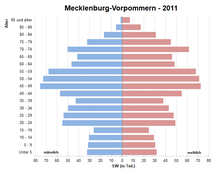
Population pyramid for Mecklenburg-Western Pomerania (data source: Census 2011)
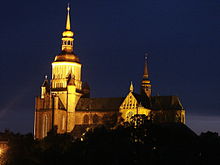
Evangelical Church of St. Mary in Stralsund

Catholic Church of Mary Queen of the Rosary in Demmin
Culture
Language
In large parts of the country, Low German ("Plattdütsch") is still at least understood and sometimes spoken by the older generation in addition to High German. The younger ones master it less often. Today, there are various initiatives to bring the regional language of their homeland closer to the younger generations with diverse school projects, club work, competitions and festivals.
The so-called Mecklenburg-Vorpommern language area belongs to East Low German and corresponds roughly to the present-day borders of the state of Mecklenburg-Vorpommern. There are no clearly definable boundaries between Mecklenburg and Vorpommern Low German, but the dialectal differences are expressed geographically in a west-east continuum. Thus, there are no bundles of isoglosses.
The Pomeranian Dictionary and the Mecklenburg Dictionary established themselves for the documentation of both language areas. Important Low German writers from the region include Fritz Reuter, John Brinckman and Rudolf Tarnow. Among the most important historical writings of the region is the Middle Low German Barth Bible.
In addition to Low German, there are also Mark-Brandenburg dialects, which are close to the Berlin dialect, especially in the eastern part of Vorpommern due to the long affiliation with Prussia and the "uckermärkische Zipfel" around Strasburg.
Among others, the language societies of the Fritz Reuter Society based in Neubrandenburg, the Johannes Gillhoff Society based in Ludwigslust-Glaisin and the John Brinckman Society based in Jürgenstorf are committed to maintaining the Mecklenburg-Vorpommern variations of Low German. In addition, there are local heritage societies and Low German cultural groups in many places that are concerned with the preservation of Low German.
Architectural monuments
→ Main article: List of architectural monuments in Mecklenburg-Western Pomerania
Museums
See also: List of museums in Mecklenburg-Vorpommern
Notable museums in MV include the Staatliches Museum Schwerin, the Pommersche Landesmuseum in Greifswald and the Phantechnikum in Wismar. The Darwineum in the Rostock Zoo combines a museum experience exhibition with a zoological collection. The German Oceanographic Museum with the Ozeaneum and the Nautineum in Stralsund is the most visited museum in northern Germany. The Müritzeum in Waren (Müritz) features Europe's largest freshwater aquariums for native fish species.
Important art exhibitions besides the Schwerin Old & New Masters Gallery include the Kunsthalle Rostock and the Ahrenshoop Art Museum, and there are also valuable exhibits at changing locations, such as the Neubrandenburg Art Collection.
The oldest museum in Mecklenburg-Vorpommern is the Stralsund Museum of Cultural History. Rostock's counterpart is located in the Holy Cross Monastery. The Neubrandenburg Regional Museum and Kulturquartier Mecklenburg-Strelitz in Neustrelitz are important cultural museums in the southeast of the state. In addition, there are smaller cultural and regional or local history museums in many other places, such as the Warnemünde Museum of Local History, the Folklore Museum in Schönberg, Grimmen's Mühlentor and Heringsdorf's Villa Irmgard. In addition, there are larger special exhibitions, such as in the German Amber Museum in Ribnitz-Damgarten or the Low German Bible Center in Barth.
The open-air museums in the state are also popular destinations, e.g. in Groß Raden, Klockenhagen and Schwerin-Mueß, the Slavic villages of Passentin and Neustrelitz, the Stone Age village of Kussow, the Hanseatic Quarter in Demmin and the Torgelow Ukranenland. Also outdoors are several miniature parks.
Many of the more than 2,000 palaces, castles and manor houses in the state can also be visited - some of them are run as museums, in addition to the ducal residences, for example, the castles in Burg Stargard, Penzlin, Plau, Dömitz and Neustadt-Glewe, or the castle island of Mirow, Hohenzieritz Castle, Ueckermünde Castle, Granitz Hunting Lodge on the island of Rügen and Bothmer Baroque Castle between Wismar and Lübeck.
Theater
See also: Category:Theater (Mecklenburg-Vorpommern)
The largest public theaters in the state are the Mecklenburg State Theater in Schwerin, the Volkstheater in Rostock, the Theater Vorpommern with venues in Greifswald, Stralsund and Putbus, and the Theater und Orchester GmbH Neubrandenburg/Neustrelitz with venues in Neubrandenburg and Neustrelitz. All four theaters offer drama as well as musical theater and orchestral music.
Other important theaters are the Ernst Barlach Theater in Güstrow, the Mecklenburg State Theater in Parchim, the Vorpommersche Landesbühne and the Theater Wismar. In addition, there are many mostly privately operated seasonal theaters and open-air theaters in larger cities, on the Baltic coast and in artists' villages and health resorts. The Störtebeker Festival has been held in Ralswiek on the island of Rügen since 1993. They are Germany's most successful open-air theater. The Vineta Festival on Usedom, the Pirate Open Air in Grevesmühlen and the Müritz Saga in Waren are also known beyond the state's borders.
| Theater | Visitors2010/2011 |
| Mecklenburg State Theater Schwerin | 168.177 |
| Vorpommersche Theater- und Sinfonieorchester GmbH Greifswald/Stralsund | 147.990 |
| Theater and Orchestra GmbH Neustrelitz/Neubrandenburg | 93.634 |
| Rostock Popular Theater | 111.174 |
| Vorpommern State Stage Anklam | 65.947 |
| Mecklenburg State Theater Parchim | 15.904 |
Events
Every two years, MV Day takes place as an official state festival, in 2018 in Rostock, to mark the 800th anniversary of the Hanseatic city.
Events of national importance in Mecklenburg-Vorpommern include:
Music festivals
The "Festspiele Mecklenburg-Vorpommern", held annually in summer, is a festival of classical music. The festival venues are spread throughout the state, often in manor houses, castles, churches, barns, industrial buildings and also in parks. On the Baltic coast and at the lakes, there are smaller festival series that complement the cultural offerings in the resorts with music and theater, such as the Schönberg Music Summer and the Usedom Music Festival in the fall. Like the festival, they are part of the "Musikland MV" series of events.
Other renowned music events include:
- Airbeat One: Festival for electronic dance music in Neustadt-Glewe, held annually since 2002.
- Eldena Jazz Evenings: open-air jazz festival in Greifswald-Eldena, first held in 1981. Since then, jazz musicians from all over the world have made guest appearances in Eldena every July.
- Fusion Festival: A festival for young art at the Lärz airfield south of the Müritz. It has been held annually since 1997 and is a showcase for alternative music, art and theater with worldwide appeal. Artists from the avant-garde Burning Man Festival, among others, come to the Mecklenburg Lake District for this.
- Greifswald Bach Week: Classical music series held in Greifswald since 1946.
- Honky Tonk: Annual pub music festival held in the city centers of Rostock, Schwerin, Stralsund and Wismar.
- Immergut Festival: Indie rock music festival in Neustrelitz, held annually at the end of May since 2000.
- Student festivals: Several major music events are held in the state, organized by student organizations. These include the University Day in Neubrandenburg, the Campus Spektakel in Stralsund and the Campus Open Air in Wismar. In Rostock, there is the Campuserwachen, the Campus Explosion and the Campus Sommerfest, among others. In Greifswald, in addition to the events mentioned above, there is the International Students Festival (Gristuf) with the Fête de la Musique in the summer.
- Zappanale: music festival in Bad Doberan, held since 1990. It is dedicated to the legacy of the composer and musician Frank Zappa with a wide variety of artists and interpretations.
Film
- Darss Nature Film Festival: Film festival for nature and environmental films on the Darss peninsula, held annually in autumn since 2005. The German Nature Film Award is presented during the event.
- dokumentART: Film festival for documentary films in Neubrandenburg, which has been held annually in autumn since 1992. At the same time, the festival is held in Szczecin, Poland.
- Festival im Stadthafen (FiSH): Short film festival in Rostock, primarily for young film art.
- Filmkunstfest Mecklenburg-Vorpommern: Film festival with around 17,000 visitors a year in Schwerin, where the Golden Ox has been awarded for outstanding contributions to German film culture since 2002.
Theater
- Festspiele im Schlossgarten: Operetta festival in Neustrelitz with up to 30,000 visitors, held in the castle garden since 2001.
- Müritz Saga: open-air theater that has been held annually in the summer at the amphitheater on the Mühlenberg in Waren (Müritz) since 2006.
- Pirate Open Air: open-air theater in Grevesmühlen near Wismar with more than 50,000 visitors annually, which has been held every summer since 2005.
- Schwerin Palace Festival: Opera festival in Schwerin, organized annually by the Mecklenburg State Theater since 1993. Up to 70,000 visitors attend the festival every summer.
- Störtebeker Festival: Open-air theater in Ralswiek on the island of Rügen with over 350,000 visitors annually, held every summer since 1993.
- Vineta Festival: Open-air theater in Zinnowitz on the island of Usedom, held annually in the summer since 1997.
Folk and cultural festivals
- Harvest festivals: The state harvest festival has been held on the first weekend of October since 1990. The highlight is the festivities on Sunday with an ecumenical church service, parade and presentation of the harvest crown. The 26th State Harvest Festival took place in Brüsewitz in 2016, and Siedenbollentin is the venue in 2017. Regionally, other harvest festivals are held in the fall, for example in Stralsund.
- Carnival or Fasching: There are carnival clubs in many communities in the state that organize events such as parades, sessions with "town hall lineups," guard dances, carnival speeches and dance evenings. The Mecklenburg-Vorpommern Carnival Association is the umbrella organization for 82 carnival clubs in the state, in which around 6000 carnivalists are active.
- Kulturpark festivals: Neubrandenburg's Kulturpark regularly hosts popular festivals that have an appeal beyond the state's borders, such as the Whitsun Festival, the Fountains in Flames light festival (Nordlichtzauber) and the Mecklenburg Oktoberfest.
- Martensmann: The tradition of the November journey of the Martensmann from Lübeck to Schwerin on St. Martin's Day has existed since 1520. It passes through Schönberg and is celebrated in Rehna and Schwerin as a folk festival or Martensmarkt.
- Nordic Sound: The largest festival of Northern European culture outside Scandinavia. It takes place annually in May in Greifswald.
- polenmARkT: The most important festival for Polish culture outside Poland. It usually takes place over ten days in November in Greifswald and surrounding towns.
- Sweden Festival: Every year in late summer, this event in Wismar commemorates the long affiliation with the Swedish crown, which began after the Thirty Years' War in 1648.
- Dancing balls: Outstanding festive ball events include the annual MV State Press Ball, the Theater Ball at the Mecklenburg State Theater in Schwerin and the Neubrandenburg Philharmonic Orchestra's Festival Ball.
- Wallensteintage: A folk festival held in Stralsund since 1825, commemorating the defense against the siege of the city by Wallenstein in 1628 every July. It is the largest historical folk festival in northern Germany.
- Christmas markets: The traditional Rostock Christmas market is considered the largest in northern Germany, and the Christmas markets of Stralsund, Wismar, Schwerin, Neubrandenburg (Weberglockenmarkt) and in the seaside resorts on the coast are also known beyond the region. But markets can also be found in smaller towns and villages, e.g. at manor houses, in the Bollewick barn and at the Zarrentin monastery.
Sports events are covered in the Sports section.
Holidays
In addition to the national holidays New Year's Day, Good Friday, Easter, Labor Day, Ascension Day, Pentecost, German Unity Day and Christmas, Reformation Day is a public holiday in Mecklenburg-Western Pomerania.
Since 2002, May 8 has been a state commemoration day in the state of Mecklenburg-Western Pomerania, as the day of liberation from National Socialism and the end of World War II.
Coins
Since 2006, 2-euro commemorative coins have been issued annually with a motif from the state that provides the president of the Bundesrat. In 2007, this was Mecklenburg-Western Pomerania; around 30 million 2-euro coins were minted with Schwerin Castle as the motif and are in circulation as official currency.
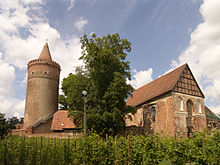
Stargard Castle with castle museum, the northernmost preserved hilltop castle in Germany
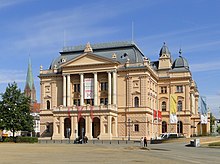
Mecklenburg State Theater in Schwerin

Neubrandenburg Concert Church, renowned venue of the Neubrandenburg Philharmonic Orchestra
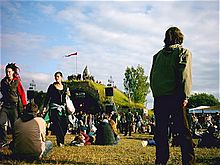
Annual Fusion Festival in Lärz
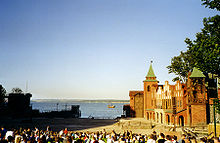
Störtebeker Festival on the island of Rügen

The state harvest festival for the 25th state anniversary took place in Semlow in 2015
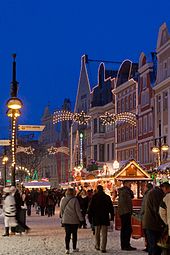
Rostock Christmas Market

Present-day distribution of East Low German
Media
Medienanstalt Mecklenburg-Vorpommern (MMV) is the legal body under the state broadcasting law that contributes to the development of radio and television and monitors the activities of private and open media stations, as well as issuing broadcasting licenses. Since 2006, it has awarded the Media Competence Prize, which recognizes outstanding achievements by committed adults and children.
Print media/newspapers
The regional daily newspapers with the highest circulation are the Ostsee-Zeitung, the Schweriner Volkszeitung with its Rostock local edition, the Norddeutsche Neuesten Nachrichten, and the Nordkurier. None of the newspapers has its own full editorial staff. In addition, there are various regional advertising papers such as the Blitz.
· 
Main building Ostsee-Zeitung in Rostock
· 
Main building Schweriner Volkszeitung in Schwerin
· 
Main building of the Nordkurier in Neubrandenburg
Radio
Radio is available for analog and digital reception. There are also various open channels, also known as citizens' radio or citizens' broadcasting.
Selection of public radio stations and their reception options:
- NDR 1 Radio MV (FM, DAB+, DVB-S)
- NDR 2 (UKW, DAB+, DVB-S)
- NDR Blue (DAB+, DVB-S)
- NDR Info (FM, DAB+, DVB-S)
- NDR Kultur (FM, DAB+, DVB-S)
- NDR Plus (DAB+, DVB-S)
- N-Joy (FM, DAB+, DVB-S)
- Deutschlandfunk (FM, DAB+, DVB-S)
- Deutschlandradio Kultur (FM, DAB+, DVB-S)
Private radio stations:
- Antenne MV (VHF)
- Ostseewelle (VHF)
- radio B2 (FM)
- Radio Paradiso (FM)
Open Radio Stations:
- LOHRO (VHF)
- NB-Radiotreff 88.0 (FM)
- radio 98eins (FM)
- Wave Kummerower See (VHF)
- Radio MSP (FM)
Internet radio
The web radios from Mecklenburg-Vorpommern include, in alphabetical order: Ostseemelodie from Schwerin, Radio Hagenow, Radio MSP from Neustrelitz, Radio Nordland from Leopoldshagen and Webradio Powerplay from Rostock. In addition, most of the terrestrially broadcast radio stations have streams that can be transmitted and received on the respective web presences.
Television
Public and private TV channels can be received via cable and satellite. Some public broadcasters are also broadcast terrestrially via DVB-T. NDR Fernsehen is the national TV station of Norddeutscher Rundfunk, which provides regional information to Hamburg, Schleswig-Holstein, Lower Saxony and Bremen, as well as Mecklenburg-Western Pomerania. NDR Fernsehen's state program is Nordmagazin. In September 2012, MV1, the first statewide private television station, went on the air.
There are individual TV stations that can broadcast locally or regionally limited to a certain area. The local offering is operated by private and open TV stations. The following local, open and private TV stations can currently be received via cable and in part via the Internet in streaming as Internet TV:
- Anklam TV - Anklam and Vorpommern-Greifswald
- aveo - My television - Schwerin and surroundings
- FAS - Television at Strelasund - Stralsund
- Television in Schwerin - Schwerin
- Greifswald TV - Greifswald
- Güstrow TV - Güstrow
- MV1
- Neu.Eins - Neubrandenburg and surroundings
- Peene TV - Demmin and surroundings
- rok-tv - Rostock
- tv.rostock - Rostock
- Rügen TV - Rügen
- Wismar TV
- Wolgast TV - Wolgast and partly Usedom Island
- Grimmen TV - Grimmen
Film
Mecklenburg-Vorpommern is a popular panorama for German and international film productions. Filmland M-V gGmbH is the contact and also the coordinator for the film industry. The state of Mecklenburg-Vorpommern promotes young film productions, among others, by awarding the Media Competence Prize at FiSH. The Filmkunstfest Mecklenburg-Vorpommern is the most important film festival in the state and is one of the largest public festivals in Germany, where the Flying Ox is awarded as the main prize (see also Film Events).
Well-known actors from Mecklenburg-Vorpommern include Matthias Schweighöfer (a native of Anklam), Nadja Uhl (a native of Stralsund), Charly Hübner (a native of Neustrelitz), Katrin Sass (a native of Schwerin), David C. Bunners (a native of Neubrandenburg), Tim Wilde (a native of Stralsund), Jule Böwe (a native of Rostock), Devid Striesow (a native of Rügen), Hinnerk Schönemann (a native of Rostock) and Anne-Catrin Märzke (a native of Parchim).
MV as a film set
A classic film is the 1922 horror film Nosferatu - A Symphony of Horror, in which the main town is represented by Wismar. The island of Usedom served as a backdrop for the Loriot film Pappa ante portas. The television series Ein Bayer auf Rügen and Hallo Robbie! made the country and the island of Rügen known throughout Germany. The 2009 Palme d'Or-winning feature film Das weiße Band (The White Ribbon) is partly set in MV, as is the 2010 multi-award-winning thriller Der Ghostwriter. In the 2010 Sat.1 TV movie Die Grenze (The Border), Mecklenburg-Western Pomerania, by now ruled by radical leftists, splits off from the Federal Republic of Germany and continues to exist as an independent state as the "Democratic Socialist Republic of Mecklenburg-Western Pomerania." The films Die Gustloff and Die Jagd nach dem Schatz der Nibelungen are also partly set in locations in Mecklenburg and Western Pomerania. In addition, there are numerous crime films and series that use locations in Mecklenburg-Western Pomerania, including Polizeiruf 110 from Rostock (although much of it is filmed in Hamburg), the ZDF Saturday crime series Stralsund, Der Usedom-Krimi from the island of Usedom and SOKO Wismar.
Art house cinema
In addition to multiplex cinemas with several halls in the larger cities and isolated private cinemas, there is an association of cultural cinemas and film clubs, the Filmkommunikation-Landesverband Mecklenburg-Vorpommern, which is unique in Europe and in which almost all of the state's art-house cinemas (such as Li.Wu Rostock at Frieda 23, Latücht Neubrandenburg or BasisKulturfabrik Neustrelitz) and film clubs are organized. Through its structure with playback rings and mobile cinema, it enables even small places to offer sophisticated cinema, often organized on a voluntary basis and as one of the few cultural venues on site.

Antenne MV, former broadcasting house in Plate near Schwerin

Studio of tv.rostock in Südstadt

Capitol Schwerin, main venue of the Filmkunstfest MV every May
Sports
The Landessportbund Mecklenburg-Vorpommern, based in Schwerin, has been the umbrella organization for organized sports in Mecklenburg-Vorpommern since 1990. The Sportjugend MV is its youth organization. The state has produced a number of world champions and Olympic champions in various sports, such as the successful soccer club and national team players Toni Kroos and Tim Borowski, cyclists Jan Ullrich and André Greipel, rower Hannes Ocik, and triathlete and Ironman Andreas Raelert, as well as athletes from SC Neubrandenburg such as canoeist Andreas Dittmer, shot-putter Astrid Kumbernuss and sprinter Katrin Krabbe. FC Hansa Rostock played in the 1st Soccer League for over 12 years and is the most successful team from the former eastern part of Germany to date. The state also has successful athletes and clubs in volleyball, handball, horseback riding, motor sports, boxing and other sports. Historically, Friedrich Ludwig Jahn, a sports and home teacher in Neubrandenburg from 1802 to 1804 and founder of the gymnastics movement, was active in the state. TSV 1814 Friedland is the oldest sports club in Germany.
Ball sports
Soccer
F.C. Hansa Rostock will play in the men's professional soccer 2nd Bundesliga in the 2021/22 season. Founded in 1965, the team is the most successful post-reunification team from East Germany with twelve Bundesliga seasons and has one of the largest fan bases of any German team.
In 2020/21, Greifswalder FC, Hansa Rostock II, TSG Neustrelitz, MSV Pampow, Torgelower FC Greif and Rostocker FC will play in the fifth-class Oberliga. The MV State Football Association organizes the MV Association League and hosts the MV Cup every year, with the winner taking part in the DFB Cup.
The Rostock Seals have been successful in beach soccer, becoming the first state champion in the MV Beach Soccer Tour in 2014 and winning several German and international tournaments. Since 2013, the nationwide DFB Beach Soccer Cup has been held in Rostock-Warnemünde. In addition, there is indoor soccer in the state according to the rules of Futsal.
Volleyball
The Schweriner SC volleyball team is represented in the 1st Women's Bundesliga and is a twelve-time German champion, most recently in 2018. The women of 1st VC Stralsund and VC Olympia Schwerin play in the Second Women's Bundesliga. In the men's division, SV Warnemünde plays in the 2nd Bundesliga Nord. The annual Usedom Beach Cup is considered the competition with the largest number of participants in beach volleyball worldwide.
Handball
HC Empor Rostock and Mecklenburger Stiere Schwerin play in the 3rd league. Several teams from Mecklenburg-Vorpommern also play in the Handball-Oberliga.
Basketball
In basketball, the Rostock Seawolves have been playing in the top division of the 2nd Basketball Bundesliga, the ProA, since the 2018/19 season.
Ice hockey
The Rostock Piranhas ice hockey team has been playing in the Ice Hockey Oberliga Nord (3rd league) since the 2010/11 season.
Field hockey
In indoor field hockey, the annual Höcker tournament in Güstrow is of nationwide importance.
Golf
Golf is enjoying increasing popularity, especially due to the creation of new courses, also for beginners. In 2011, the Mecklenburg-Vorpommern Golf Association had around 13,500 members, about half of them from other German states and abroad. Major tournaments are held at the WINSTONopen in Vorbeck near Schwerin, among others.
More
In table tennis, TTSV 90 Neubrandenburg organizes the "Table Tennis Tournament of a Thousand" every year. Team UWR 071 Rostock has been playing in the 1st national league in underwater rugby since the 2013/2014 season. Demminer Radballverein played from the 2008/2009 to 2013/2014 season in the 2nd Bundesliga in cycle ball. Since the 2018/2019 season they are again in the second division. The DBU coordinates the field of billiards, MV belongs within it to the North German Billiards Association.
Water sports
Sailing
Sailing is practiced on the Baltic coast and on the numerous smaller waters. Regattas are held on most of the larger waters. Large annual sporting events around sailing are the Hanse Sail and the Warnemünder Woche in Rostock. In Stralsund the harbor festival takes place every summer, in Wismar there are the harbor days and in Sassnitz on Rügen Sail Sassnitz. In Ueckermünde, the Haff Sail is held annually. In the inland the Müritz Sail in Waren is popular, on the Tollensesee in Neubrandenburg is sailed for the "blue ribbon". The Mecklenburg-Vorpommern Sailing Association, headquartered in Rostock-Warnemünde, oversees most of the local sailing clubs.
Windsurfing and kitesurfing
The Baltic coast and many lakes are suitable for windsurfing and kitesurfing. Over 50 surf spots are established, as well as numerous surf schools.
Canoeing
Paddle sports are popular throughout the country - canoe, kayak and dragon boat clubs are everywhere. The trendy sport of stand-up paddling is also becoming increasingly popular. The State Canoe Association of MV has its headquarters in Neubrandenburg. The annual outrigger regatta in canoeing also takes place there.
Swimming
Every year, more than a thousand swimmers swim across the Strelasund at the Stralsund Sund Swim. The Müritz Swim is a competition that has been held since 1969. The MV Swimming Association is based in Rostock and, in addition to the swimmers, also looks after the water jumpers and water polo players.
Diving
Scuba diving is possible throughout the country in many inland lakes as well as in the Baltic Sea. Many diving centers offer introductory diving, diving training, guided tours and/or equipment.
Other sports
Motorsport
In motorsports, annual highlights are the International Hill Climb Race at the Teterow Hill Climb at Whitsun, with the evening speedway race for the Auerhahn Cup in the Bergring Arena, the international speedway race for the Whitsun Cup in Güstrow in the stadium at Plauer Chaussee and in Stralsund the Speedway Bundesliga and the International Speedway Baltic Cup. The annual stock car races in the "Hexenkessel" of Grimmen, as well as in Sanitz (Wendorf) and Stavenhagen ("Basepohler PS-Hölle") are very popular with starters and spectators. In motoball ("motorcycle soccer"), MSC Kobra Malchin and MSC Jarmen are successful.
One competitive rally is the summer ADAC rally sprint "Rund um den Bergring" in Teterow. Classic car rallies take place throughout the state; popular events include the Kaiser Classic Tour across the island of Usedom, the Rügenclassics, which leads across Rügen, and the ADAC Sunflower Rally in western Mecklenburg, which is used by many classic and vintage car drivers. There are several motorsport race tracks and kart tracks in the state. The Landes-Motorsport-Fachverband MV (LMFV), based in Rostock, primarily coordinates activities in the areas of motorcycling and karting.
Martial Arts
The most popular martial arts in MV include boxing and kickboxing, judo, jiu jitsu and karate. The Boxing Union MV has over 1500 members, the Karate Union Mecklenburg-Vorpommern has 37 member clubs. For a wide audience, several Fight Nights with different martial arts take place each year. Several world champion fights in boxing took place in the Sport- und Kongresshalle Schwerin and in the Jahnsportforum Neubrandenburg. Some well-known boxing world champions come from the state, including Sebastian Sylvester and Jürgen Brähmer. Probably the most famous German boxer, Max Schmeling (1905-2005), was born in Klein Luckow, which was then part of Mecklenburg-Vorpommern. The successful boxing trainers Fritz Sdunek (1947-2014) and Michael Timm (* 1962) are also well-known.
Horse riding
Equestrian sports play a major role in Mecklenburg-Vorpommern and have a long tradition. The Redefin State Stud is world-famous for its stallion breeding and the parades and trainings held there. André Thieme from Plau am See is one of the most successful show jumpers in the world. The Baltic Sea racecourse in Bad Doberan is the oldest on the European mainland. The equestrian sports association MV has its headquarters in Rostock.
Cycling
Cycling is popular among all age groups. There is a 250-meter cycling track in Rostock. Since 2014, the Mecklenburg Lakes Circuit, which starts and finishes in Neubrandenburg, has been the largest everyman race in Germany and is to be established in subsequent years as a European cycling race that could become part of the UCI Europe Tour.
Runs
The Rügen Bridge Run with Marathon takes participants over the Rügen Bridge every year. Other popular marathon routes lead through Rostock, around the Müritz, around the Tollensesee, over Usedom, the Darß and along the Stettiner Haff.
Air sports
Air sports are popular especially outside the winter months, e.g. aerobatics, ultralight flying, paragliding and hang gliding. In addition to the larger airfields, there are numerous small flying bases and glider sites where practice hours can be taken. The Luftsportverband MV organizes, among other things, the annual air rally and the German championship in powered flight at Neubrandenburg Airport.
Shooting sports
More than 180 shooting clubs are coordinated by the Landesschützenverband Mecklenburg-Vorpommern e.V. (LSV M-V) with its headquarters in Neubrandenburg.

Ostseestadion, home of Hansa Rostock
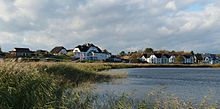
Balmer See Golf Club on Usedom
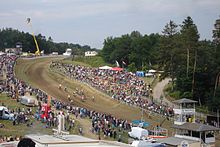
Hill climb race in Teterow
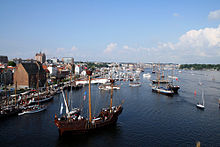
Hanse Sail in Rostock

The number of club athletes in MV has risen steadily since 1991.
See also
![]()
Portal: Mecklenburg-Western Pomerania - Overview of Wikipedia content on Mecklenburg-Western Pomerania
- Personalities (Mecklenburg-Western Pomerania)
- Mecklenburg cuisine and Pomeranian cuisine
- Police Mecklenburg-Western Pomerania
Search within the encyclopedia

.svg.png)
.svg.png)

.svg.png)

.svg.png)

.svg.png)
